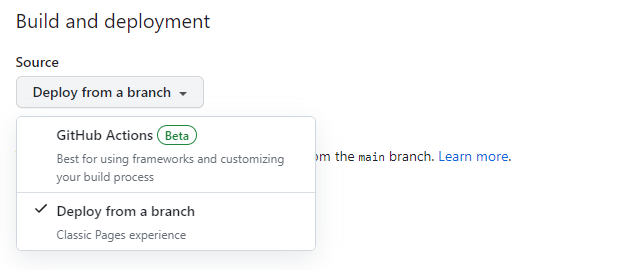Host your Hugo Generated site on GitHub
GitHub Pages are are a great way to host a blog, share your résumé, or even host a website about one of your projects. GitHub provides first class support for Jekyll but what if you wanted to use a different Static Site Generator like Hugo?
Thankfully it’s super easy to set up. Follow along as we configure the example site for the Peripheral theme to deploy to GitHub Pages automatically using GitHub actions.
Configure the repository
The repository hosting the content of your GitHub site needs to be configured to support customising the build process.
Change the deployment source to GitHub Actions, you will find this under Settings > Pages.

Configure GitHub actions
Create a new workflow called something nice like hugo.yml and place it in the wellknown workflow folder .github/workflows.
This files will contain our workflow definition to deploy the site to GitHub pages. The workflow doesn’t use any third party actions for security.
Then add the following sections
Workflow name
This is the name of the workflow which will appear in the GitHub UI
# Deploying Hugo site to GitHub Pages
name: Build and deploy to Pages
Run triggers
This defines how the workflow is triggered, we’ll trigger it when new code is pushed or manually.
on:
# Runs on push to main branch
push:
branches: ["main"]
# Allow to be manually started from the Action tab
workflow_dispatch:
Permissions
This section grants permission to the jobs in the workflow to interact with GitHub pages
# Allow deployment to GitHub Pages
permissions:
contents: read
pages: write
id-token: write
Concurrency
This section is optional, we are disabling concurrent deployments but not cancelling in progress jobs so we don’t interrupe the build
# Allow only one concurrent deployment
concurrency:
group: "pages"
cancel-in-progress: false
The build and deploy jobs
This is the core part of the workflow where we specify how our hugo site is built and deployed
jobs:
deploy:
environment:
name: github-pages
url: ${{ steps.deployment.outputs.page_url }}
runs-on: ubuntu-latest
steps:
Preparing the workflow
The first few steps are to checkout the code, set up pages, and download Hugo.
- name: 💾 Checkout
uses: actions/checkout@v3
with:
submodules: true #Themes in Hugo are usually submodules
- name: 📄 Setup Pages
uses: actions/configure-pages@v3
- name: ✨ Setup Hugo
env:
HUGO_VERSION: 0.111.3
run: |
mkdir ~/hugo
cd ~/hugo
curl -L "https://github.com/gohugoio/hugo/releases/download/v${HUGO_VERSION}/hugo_${HUGO_VERSION}_Linux-64bit.tar.gz" --output hugo.tar.gz
tar -xvzf hugo.tar.gz
sudo mv hugo /usr/local/bin
Build the static site
Next we generate our static website using Hugo. Use the -s parameter to define where the website is in relation to the source root. Use the -d parameter to define where the generated site should be saved to. The --environment parameter is used to specify the configuration to use. For this example this sets up the Base URL correctly to deploy to GitHub pages.
- name: 🛠️ Build website
run: hugo -s ${{github.workspace}}/quickstart -d ${{github.workspace}}/dist --environment github-pages --log -v
Deploy to pages
Finally upload the generated files to GitHub pages.
- name: 📦 Upload artifact
uses: actions/upload-pages-artifact@v1
with:
path: '${{github.workspace}}/dist'
- name: 🚀 Deploy to GitHub Pages
id: deployment
uses: actions/deploy-pages@v2
That’s it! You can see the final file here, and see the deployed example site here.
In the next installment we’ll look at how we update some Hugo Configration parameters at build time.
